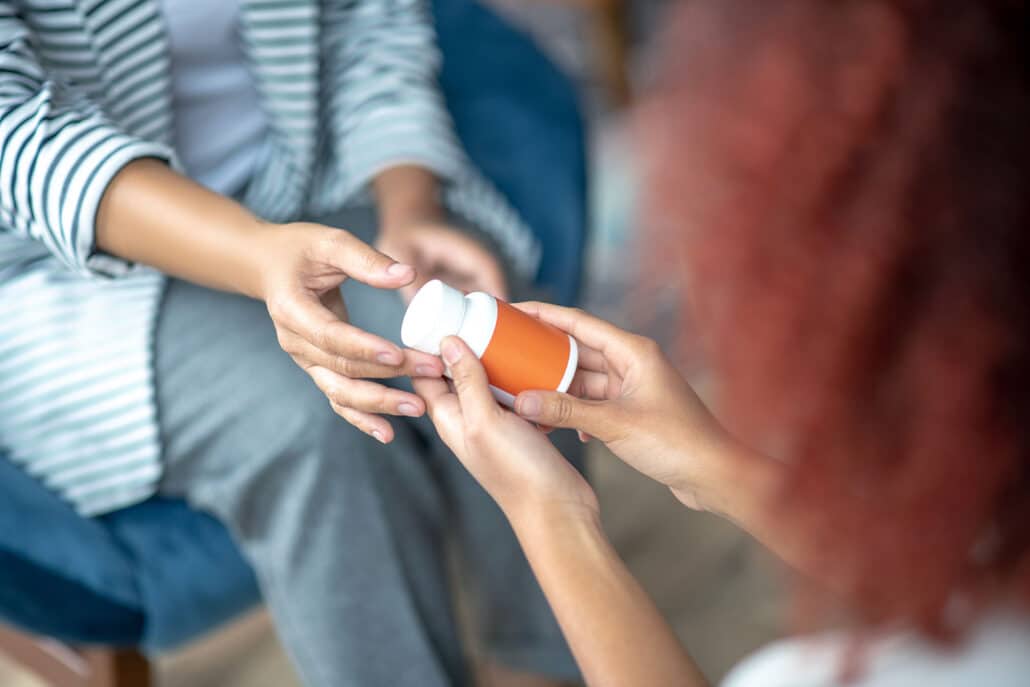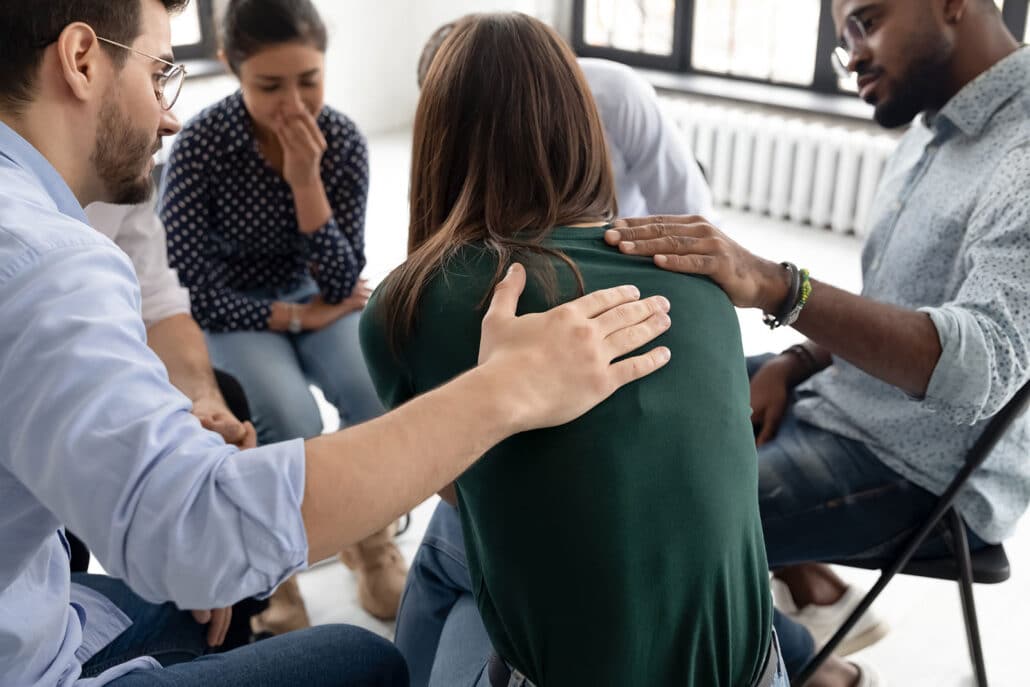In 2021, the use of hallucinogenic drugs reached historic highs among adults from 19 to 30 years old.
Also known as psychedelics, deliriants, and dissociatives, examples of hallucinogens include LSD, mescaline, MDMA, peyote, ketamine, PCP, and psilocybin (shrooms). Such drugs exhibit mood- and perception-altering effects that ultimately distort the connection between individuals’ minds and reality.

Compared to other illicit drugs such as opioids, alcohol, and stimulants, hallucinogens are one of the least addictive substances. However, their abuse and consequent addiction can result in many dangerous and potentially fatal impacts.
With the rate of using hallucinogens for their psychoactive influence increasing at an alarming rate, the risk of abuse and addiction has never been higher. Specialized treatment for hallucinogen abuse disorder is the only way to recover from hallucinogen addiction.
Treatment options commonly feature behavioral therapy as part of inpatient and outpatient programs. Medications can also be used to manage withdrawal symptoms and co-occurring mental conditions.
Table of Contents
Understanding Hallucinogen Addiction
Hallucinogens are types of drugs that alter your awareness of reality. Let’s take a closer look at their definitions, types, and causes/risk factors.
What Are Hallucinogens?
A diverse group of drugs (both naturally occurring and man-made) forms the class of hallucinogens, which is further divided into 2 main categories as discussed in the following section.
These drugs take a person’s mind on a chemically-induced experience (commonly referred to as an acid trip) where their sense of reality is warped.
Many users take hallucinogens as a route to “expand” their minds for recreational or experimental purposes. Others use it for healing purposes or as a component of religious rituals.
The repeated use of hallucinogens can lead to a type of substance use disorder known as hallucinogen use disorder where the individual continues to take the drugs despite causing problems in their work, social life, mental, and physical health.
When under the effect of hallucinogens, people experience emotions, sensations, and thoughts that aren’t real. There’s a characteristic sense of detachment, either from the world or one’s self.
Types of Hallucinogens
Generally speaking, there are 2 primary types of hallucinogens:
Classic Hallucinogens
These include:
- LSD: Commonly known as acid, LSD is one of the most potent and widespread hallucinogenic drugs out there. It’s available as pills, tongue stamps, and liquids.
- Psilocybin: Commonly known as shrooms, this drug is present in mushrooms that can be consumed raw, dried, or as tea.
- Mescaline: Also referred to as peyote, mesc, buttons, and cactus, this drug is the active constituent in a small cactus called peyote. Native to the southwestern regions of the country, the cactus can be chewed or soaked to make tea
- DMT: Naturally occurring and synthetically produced, DMT is typically snorted or smoked but people can also drink it. Its psychoactive effects last for about an hour.
- Ecstasy: Also called Molly or MDMA, ecstasy is mostly available as tablets. This drug’s popularity in party settings is due to having both stimulant and hallucinogenic effects.
Dissociative Drugs
These include:
- Ketamine: Also known as special K, ketamine can be injected (liquid), snorted (powder), or swallowed (pills). It has no taste or smell and can cause memory loss, so it’s used as a date rape drug.
- DXM: Otherwise known as Robo, Poor Man’s PCP, or Dex, Dextromethorphan is a cough suppressant commonly added to over-the-counter cold and cough medications. Its hallucinogenic effects happen after consuming high doses.
- PCP: Also referred to as angel dust, phencyclidine is synthesized as powder, liquid, or pills. It can be smoked, injected, snorted, or swallowed.
What Are the Causes and Risk Factors of Hallucinogen Addiction?
The reasons why some people are more prone to hallucinogen addiction than others are generally either genetic or environmental.

Substance abuse problems can pass down from generation to generation. Individuals are likely to struggle with addiction (hallucinogenic or other drugs) if there are certain genes present in their DNA.
This means that if members of an individual’s family had/have addiction problems, it can serve as an indication of potential substance abuse disorders.
An individual’s environment can also affect their vulnerability to grappling with hallucinogenic abuse and addiction.
Examples of such environmental aspects include the places where they hang out, the experiences they’ve been through, and the people they spend time with.
Lack of a support system and unhealthy stress coping mechanisms can also play a role in a person’s susceptibility to abusing hallucinogens.
This information makes way for risk factors of hallucinogen addiction, which include:
- History of substance abuse disorders in the family
- Personal history of substance abuse disorders
- Age group 18 to 30
- Ability to easily access illicit drugs
- History of mental disorders in the family
- Personal history of mental disorders
How Does Hallucinogen Addiction Affect Physical and Mental Health?
Hallucinogen addiction (which is mostly psychological rather than physical, can lead to devastating penalties. These short- and long-term negative consequences not only affect the user’s mind but also their body and social/professional life.
The side effects of hallucinogen addiction on physical health include:
- Blurred vision
- Difficulty breathing
- Rapid breathing
- Increase in body temperature (hyperthermia)
- Decrease in body temperature (hypothermia)
- Impaired motor abilities
- Slurred speech
- Illogical speech
- Sensory distortions
- Inability to feel pain
- Dilated pupils
- Seizures
- Coma
- Stroke
- Memory loss
- Respiratory failure
- Death
The side effects of hallucinogen addiction on mental health include:
- Anxiety
- Confusion
- Seeing things or hearing sounds that aren’t there (hallucinations)
- Paranoia
- Objects look like they’re breathing
- Panic attack
- Feeling detached
- Mood swings
- Irritability
- Violence
- Amnesia
- Euphoria
- Major depression
- Schizophrenia triggers
- Suicidal tendencies
- Psychosis
The side effects of hallucinogen addiction on aspects of personal life include:
- Withdrawing from normal activities
- Family problems
- Failure in career
- Tensions in romantic relationships
- Friendships are strained or cut off
- Financial struggles
Types of Hallucinogen Addiction Treatment Programs
Various treatment options are available for hallucinogen addiction depending on the patient’s case.

Considering factors such as the type of hallucinogen, severity of abuse, co-occurring psychological and/or physical conditions, and social/emotional issues helps determine the best approach to recovery.
The following are the most common hallucinogen addiction treatment programs:
Inpatient Treatment
This treatment approach involves admitting patients to specialty units in hospitals or separate medical facilities to receive supervised treatment (medical and/or behavioral) in a controlled environment.
During the duration of treatment, patients have access to medical care and emotional support 24/7.
This treatment option is best suited for the most severe hallucinogen addiction cases. For example, patients with co-occurring serious mental disorders.
Residential Treatment
This treatment approach involves admitting patients to residential treatment centers. These vary in levels from hotel-like establishments to hospital-like facilities.
Similar to the inpatient approach, the foundation of residential treatment is the availability of medical care and emotional support 24/7 in a controlled environment throughout the treatment.
Residential treatment can be as brief as 1 month or as long as 1 year.
This treatment option is best suited for hallucinogen addiction cases of medium to high severity.
Outpatient Treatment
This treatment approach involves patients committing to a part-time recovery plan. They attend treatment and therapy sessions without having to stay in the facility, allowing them flexibility in keeping up with school, work, and social obligations.
Treatment sessions take place in specialized facilities and are no more than 9 hours per week. After the day’s agenda is complete, patients are free to leave.
A health professional assesses the patient’s case after finishing a certain period in residential or inpatient treatment to determine if they’re ready for outpatient treatment.
This treatment option is best suited for hallucinogen addiction cases of low to medium severity.
Partial Hospitalization Programs
A partial hospitalization program (PHP) is a step-down treatment strategy that comes after residential or inpatient treatment. The purpose of PHP is to prepare the recovering user for the less intense supervision waiting for them in outpatient treatment.
We can refer to PHP as a middle ground between inpatient/residential and outpatient treatment.

In PHP, patients receive at least 20 hours of treatment per week, distributed over 5 to 7 days. This method offers structured and comprehensive treatment thanks to the required daily contact and reporting.
In PHP, the patient doesn’t get 24-hour care. They go in for a few hours and go back home once the daily agenda is over.
PHP offers more flexibility than inpatient and residential programs, but it also provides medical services if needed.
This treatment option is best suited for hallucinogen addiction cases of medium to high severity.
Intensive Outpatient Programs
An intensive outpatient program (IOP) is also a step-down treatment strategy that typically follows residential or inpatient treatment.
Similar to PHP, its purpose is to prepare the recovering patient for the less intense care level waiting for them in outpatient treatment.
As such, IOP is regarded as a middle ground between PHP and outpatient treatment.
In IOP, patients receive between 10 to 20 hours of treatment per week, distributed over 5 to 7 days. They attend sessions at a specialized facility but they leave once they’re done for more freedom.
IOP also doesn’t offer 24-hour care. However, it differs from PHP in that IOP doesn’t provide medical services.
This treatment option is best suited for hallucinogen addiction cases of medium to high severity.

Components of Effective Hallucinogen Addiction Treatment Programs
Now that you have a better understanding of hallucinogen addiction treatment options, here are some of the treatment elements usually included in these programs:
Evidence-based Therapies
Also referred to as behavioral therapy, this type of treatment is one of the most effective against substance abuse issues.
Hallucinogen addiction behavioral treatment features multiple types of therapy, including
- Cognitive-behavioral therapy (CBT): In these sessions, the therapist helps the patient process their thoughts and emotions to understand the relationship between their addiction and problematic behaviors.
- Dialectical behavior therapy (DBT): Based on CBT, DBT is a type of talking therapy that aims to help patients accept difficult feelings, comprehend them, and learn different ways for managing them to enable the regulation of potentially destructive behaviors.
- Motivational interviewing (MI): In these sessions, the therapist asks the patient insightful questions to help boost their motivation towards making a change
Individual and Group Counseling
Individual therapy involves a licensed professional who’ll work with the patient on their mental health and offer a safe space to discuss their thoughts, feelings, and issues.
During these one-on-one sessions, the patient opens up about their problems and emotions. The therapist helps them deal with psychological issues to improve their control over triggers that promote substance abuse.
Group therapy, on the other hand, involves certified facilitators who hold/run meetings with multiple participants who are also recovering addicts and going through the same hardships.
Family Therapy and Support
This type of therapy offers patients and their family members proper guidance to improve communication and work through lingering issues. Family members learn how to correctly provide support to the patient while eliminating codependency and enabling behaviors.
Relapse Prevention and Aftercare Planning
Hallucinogens addiction treatment programs also include aftercare planning to help patients beyond the direct recovery process.
Typically, these plants are part of outpatient care. It includes strategies such as support groups and 12-step programs.

Managing Hallucinogen Withdrawal Symptoms and Cravings
Medications for hallucinogen addiction treatment are yet to be approved by the FDA. However, some medications -such as anxiolytics and sedatives- can be administered to help alleviate withdrawal symptoms.
Hallucinogen withdrawal symptoms may include:
- Confusion
- Anxiety
- Depression
- Impaired reflexes
- Tremors
- Seizures
- Diminished speech
- Memory issues
- Agitation
How to Choose the Right Hallucinogen Addiction Treatment Program
First, a professional health provider evaluates the patient’s case through a question-based interview and a review of the individual’s health state and preferences.
This assessment provides an outline of the type and level of care required to begin recovery.
From there, you can start researching treatment centers and compare the specifics of the programs they offer.
The cost of a program depends on its length, the included features, the location of the facility, and the extent of your insurance coverage
Final Thoughts
Achieving and maintaining long-term recovery from hallucinogen abuse is possible through professional treatment.
If you or anyone you know requires help in their journey to beat hallucinogen addiction, don’t hesitate to reach out.

